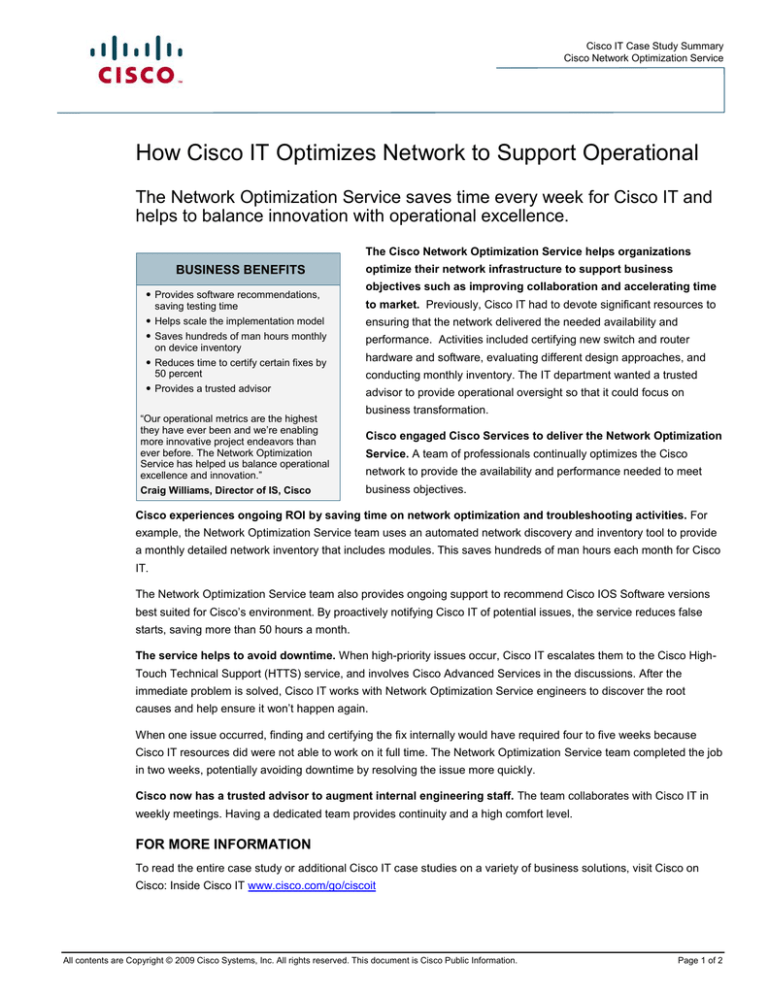
Cisco IT Case Study Summary
Cisco Network Optimization Service
How Cisco IT Optimizes Network to Support Operational
The Network Optimization Service saves time every week for Cisco IT and
helps to balance innovation with operational excellence.
The Cisco Network Optimization Service helps organizations
BUSINESS BENEFITS
● Provides software recommendations,
saving testing time
optimize their network infrastructure to support business
objectives such as improving collaboration and accelerating time
to market. Previously, Cisco IT had to devote significant resources to
● Helps scale the implementation model
ensuring that the network delivered the needed availability and
● Saves hundreds of man hours monthly
performance. Activities included certifying new switch and router
on device inventory
● Reduces time to certify certain fixes by
50 percent
● Provides a trusted advisor
“Our operational metrics are the highest
they have ever been and we’re enabling
more innovative project endeavors than
ever before. The Network Optimization
Service has helped us balance operational
excellence and innovation.”
Craig Williams, Director of IS, Cisco
hardware and software, evaluating different design approaches, and
conducting monthly inventory. The IT department wanted a trusted
advisor to provide operational oversight so that it could focus on
business transformation.
Cisco engaged Cisco Services to deliver the Network Optimization
Service. A team of professionals continually optimizes the Cisco
network to provide the availability and performance needed to meet
business objectives.
Cisco experiences ongoing ROI by saving time on network optimization and troubleshooting activities. For
example, the Network Optimization Service team uses an automated network discovery and inventory tool to provide
a monthly detailed network inventory that includes modules. This saves hundreds of man hours each month for Cisco
IT.
The Network Optimization Service team also provides ongoing support to recommend Cisco IOS Software versions
best suited for Cisco’s environment. By proactively notifying Cisco IT of potential issues, the service reduces false
starts, saving more than 50 hours a month.
The service helps to avoid downtime. When high-priority issues occur, Cisco IT escalates them to the Cisco HighTouch Technical Support (HTTS) service, and involves Cisco Advanced Services in the discussions. After the
immediate problem is solved, Cisco IT works with Network Optimization Service engineers to discover the root
causes and help ensure it won’t happen again.
When one issue occurred, finding and certifying the fix internally would have required four to five weeks because
Cisco IT resources did were not able to work on it full time. The Network Optimization Service team completed the job
in two weeks, potentially avoiding downtime by resolving the issue more quickly.
Cisco now has a trusted advisor to augment internal engineering staff. The team collaborates with Cisco IT in
weekly meetings. Having a dedicated team provides continuity and a high comfort level.
FOR MORE INFORMATION
To read the entire case study or additional Cisco IT case studies on a variety of business solutions, visit Cisco on
Cisco: Inside Cisco IT www.cisco.com/go/ciscoit
All contents are Copyright © 2009 Cisco Systems, Inc. All rights reserved. This document is Cisco Public Information.
Page 1 of 2
Cisco IT Case Study Summary
Cisco Network Optimization Service
NOTE
This publication describes how Cisco has benefited from the deployment of its own products. Many factors may have
contributed to the results and benefits described; Cisco does not guarantee comparable results elsewhere.
CISCO PROVIDES THIS PUBLICATION AS IS WITHOUT WARRANTY OF ANY KIND, EITHER EXPRESS OR
IMPLIED, INCLUDING THE IMPLIED WARRANTIES OF MERCHANTABILITY OR FITNESS FOR A PARTICULAR
PURPOSE.
Some jurisdictions do not allow disclaimer of express or implied warranties, therefore this disclaimer may not apply to
you.
All contents are Copyright © 1992–2008 Cisco Systems, Inc. All rights reserved. This document is Cisco Public Information.
Page 2 of 2


